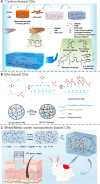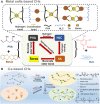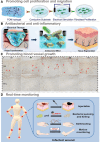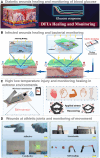Conductive hydrogels: intelligent dressings for monitoring and healing chronic wounds
- PMID: 39776855
- PMCID: PMC11703555
- DOI: 10.1093/rb/rbae127
Conductive hydrogels: intelligent dressings for monitoring and healing chronic wounds
Abstract
Conductive hydrogels (CHs) represent a burgeoning class of intelligent wound dressings, providing innovative strategies for chronic wound repair and monitoring. Notably, CHs excel in promoting cell migration and proliferation, exhibit powerful antibacterial and anti-inflammatory properties, and enhance collagen deposition and angiogenesis. These capabilities, combined with real-time monitoring functions, play a pivotal role in accelerating collagen synthesis, angiogenesis and continuous wound surveillance. This review delves into the preparation, mechanisms and applications of CHs in wound management, highlighting their diverse and significant advantages. It emphasizes the effectiveness of CHs in treating various chronic wounds, such as diabetic ulcers, infected wounds, temperature-related injuries and athletic joint wounds. Additionally, it explores the diverse applications of multifunctional intelligent CHs in advanced wound care technologies, encompassing self-powered dressings, electrically-triggered drug delivery, comprehensive diagnostics and therapeutics and scar-free healing. Furthermore, the review highlights the challenges to their broader implementation, explores the future of intelligent wound dressings and discusses the transformative role of CHs in chronic wound management, particularly in the context of the anticipated integration of artificial intelligence (AI). Additionally, this review underscores the challenges hindering the widespread adoption of CHs, delves into the prospects of intelligent wound dressings and elucidates the transformative impact of CHs in managing chronic wounds, especially with the forthcoming integration of AI. This integration promises to facilitate predictive analytics and tailor personalized treatment plans, thereby further refining the healing process and elevating patient satisfaction. Addressing these challenges and harnessing emerging technologies, we postulate, will establish CHs as a cornerstone in revolutionizing chronic wound care, significantly improving patient outcomes.
Keywords: chronic wound; conductive hydrogels; electrical stimulation; intelligent dressing; real-time monitoring.
© The Author(s) 2024. Published by Oxford University Press.
Figures








Similar articles
-
Multifunctional and theranostic hydrogels for wound healing acceleration: An emphasis on diabetic-related chronic wounds.Environ Res. 2023 Dec 1;238(Pt 1):117087. doi: 10.1016/j.envres.2023.117087. Epub 2023 Sep 15. Environ Res. 2023. PMID: 37716390 Review.
-
Smart Dressings and Their Applications in Chronic Wound Management.Cell Biochem Biophys. 2024 Sep;82(3):1965-1977. doi: 10.1007/s12013-024-01402-w. Epub 2024 Jul 5. Cell Biochem Biophys. 2024. PMID: 38969950 Review.
-
A conductive multifunctional hydrogel dressing with the synergistic effect of ROS-scavenging and electroactivity for the treatment and sensing of chronic diabetic wounds.Acta Biomater. 2023 Sep 1;167:348-360. doi: 10.1016/j.actbio.2023.05.045. Epub 2023 Jun 2. Acta Biomater. 2023. PMID: 37270075
-
Intelligent hydrogel-based dressings for treatment of chronic diabetic wounds.World J Diabetes. 2025 May 15;16(5):104937. doi: 10.4239/wjd.v16.i5.104937. World J Diabetes. 2025. PMID: 40487617 Free PMC article. Review.
-
Functional Hydrogels as Wound Dressing to Enhance Wound Healing.ACS Nano. 2021 Aug 24;15(8):12687-12722. doi: 10.1021/acsnano.1c04206. Epub 2021 Aug 10. ACS Nano. 2021. PMID: 34374515 Review.
Cited by
-
Engineering of tissue in microphysiological systems demonstrated by modelling skeletal muscle.Regen Biomater. 2025 Jun 16;12:rbaf059. doi: 10.1093/rb/rbaf059. eCollection 2025. Regen Biomater. 2025. PMID: 40717794 Free PMC article. Review.
-
Advances in Nanohybrid Hydrogels for Wound Healing: From Functional Mechanisms to Translational Prospects.Gels. 2025 Jun 23;11(7):483. doi: 10.3390/gels11070483. Gels. 2025. PMID: 40710646 Free PMC article. Review.
References
-
- Li H, Li B, Lv D, Li W, Lu Y, Luo G. Biomaterials releasing drug responsively to promote wound healing via regulation of pathological microenvironment. Adv Drug Deliv Rev 2023;196:114778. - PubMed
-
- Ge Z, Guo W, Tao Y, Sun H, Meng X, Cao L, Zhang S, Liu W, Akhtar ML, Li Y, Ren Y. Wireless and closed-loop smart dressing for exudate management and on-demand treatment of chronic wounds. Adv Mater 2023;35:e2304005. - PubMed
-
- Jones RE, Foster DS, Longaker MT. Management of chronic wounds—2018. JAMA 2018;320:1481–2. - PubMed
Publication types
LinkOut - more resources
Full Text Sources

